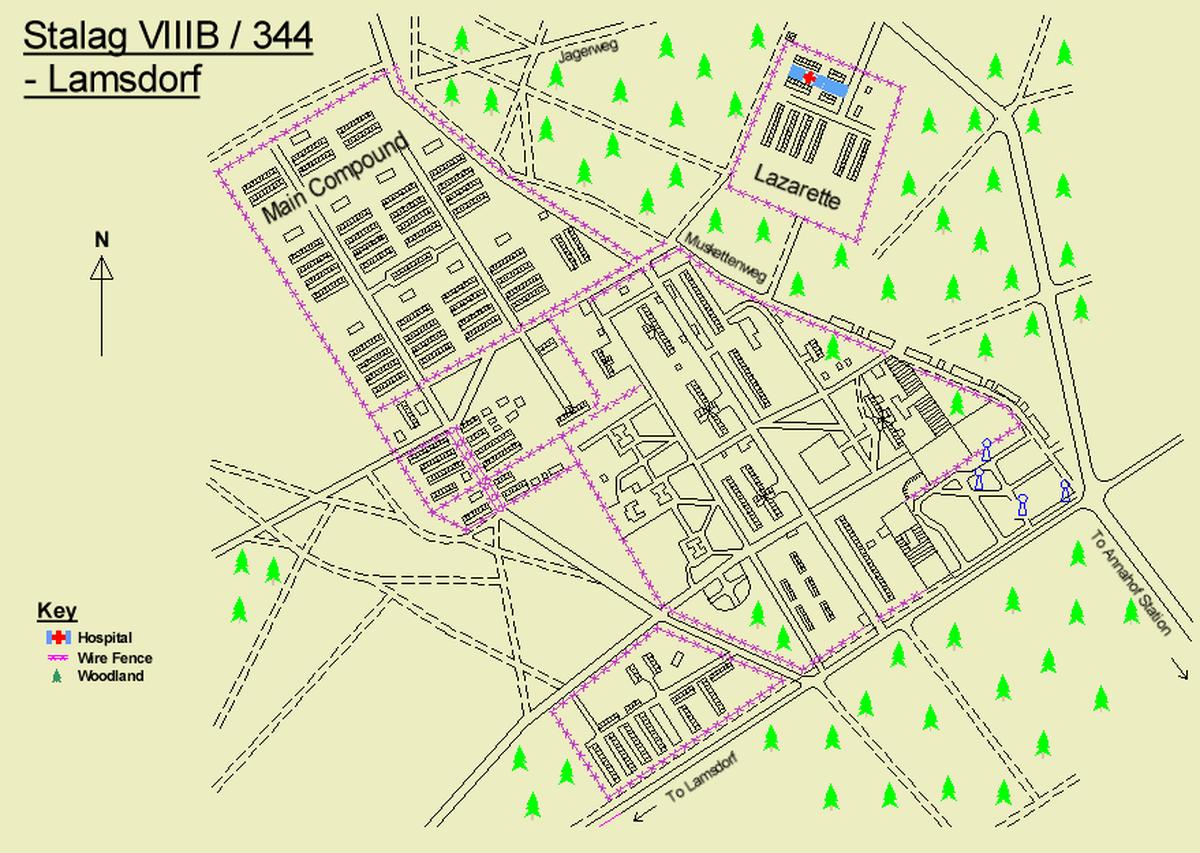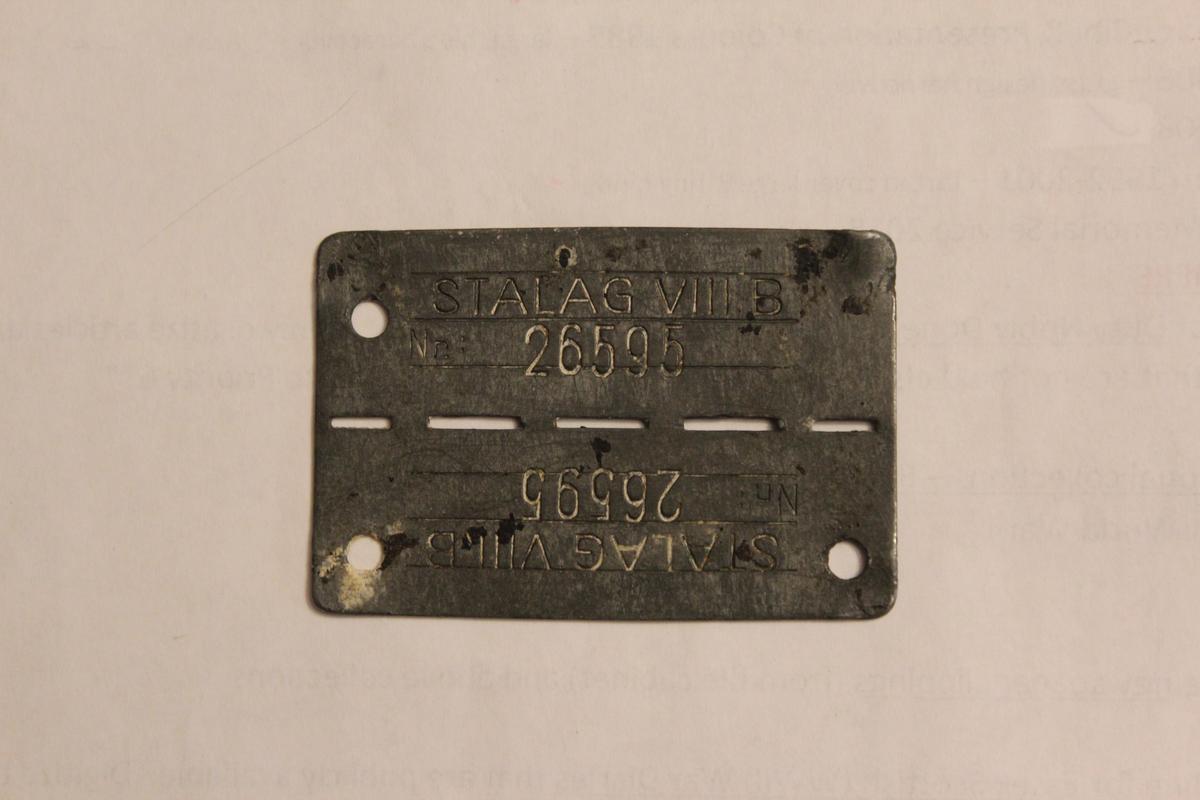Prisoner of War Experience: Stalag VIII B

A modernized drawing of Stalag VIII B. Picture provided by RSM Edward Charles Goodey, D.C.M.
Throughout World War II (1939-1945), hundreds of men from The Essex Scottish Regiment were help captive in the German Stalag VIII B prisoner of war (POW) camp. The European nations signed the second revised Geneva Convention in 1929, which outlined the treatment of imprisoned soldiers. It required that all men were to be treated humanely while imprisoned. Prisoners were entitled to proper lodging, safe work conditions, medical treatment, exercise and food rations.
After the catastrophic events of the Dieppe Raid on 19 August 1942, 390 Essex Scottish members were placed into German POW camps. The Canadian soldiers captured by German forces suffered under unregulated living standards of the prisoner camps and were susceptible to contagions and the spread of lice.
Although the revised Geneva Convention was adopted after World War I, it was not successfully mandated in German camps. In camp Stalag VIII B, located in Lamsdorf (now Lambinowice), Poland, POWs received the minimum number of required resources to keep them alive and constantly subjected to poor living conditions. This squalor began as soon as they were captured and loaded in small box cars of injured and sick men. Prisoners traveled for multiple days at a time with scarce amounts of food, water and sunlight.
While in camp, the prisoners did not receive appropriate food portions, water and heat. Food rations were too small to properly feed the hundreds of imprisoned men. The POWs heavily relied on Canadian Red Cross parcels and packages to combat their hunger and dehydration. The men created syndicates of two or three in order to share the contents of the parcels they received. In Stalag VIII B, the prisoners received one bucket of coal a day per hut in order to heat their huts during the winter. The huts housed upwards of 120 men at a time. British and Canadian prisoners constructed fan-assisted “blowers” made from flattened Red Cross parcel cans to help circulate what little heat they had in the hut.
In addition to the inhumane conditions the prisoners faced due to supply shortages, they also endured psychological warfare. Men were often tied up, tortured, and humiliated by German guards.
Despite the poor living conditions, Stalag VIII B was home to one of the best hospital facilities amongst the German prison camps during World War II. The hospital was known as “Lazarett Lamsdorf.” It was opened on 13 October 1941 and was planned to hold approximately 30,000 men. An additional eleven buildings housed operating theatres, laboratories, wards, a morgue, and kitchen. The staff in Lazarett Lamsdorf primarily consisted of Allied prisoners and soldiers, some with prior medical training, but were overseen and controlled by German medical officers. Many of the men who were placed to work in the hospitals did not have previous medical knowledge, but they helped one another through the learning process. The Medical Services in New Zealand and The Pacific noted that “the men were particularly keen; and, encouraged by their medical officers, who gave them regular courses in nursing, anatomy, physiology, etc., they rapidly achieved a remarkably high standard of nursing.”
Despite the large hospital and many staff, the medical attention POWs received was far below the standards of the revised Geneva Convention. Nevertheless, Pte. Robert Large, an Essex Scottish prisoner, recounted his experience in a German hospital before being transferred to Stalag VIII B. Large was with The Essex Scottish at Dieppe on 19 August 1942 and was one of the survivors. A mortar bomb shattered both of his legs, resulting in him losing large amounts of blood. He was captured by the German forces and transported in a box car to a German hospital in Verneul, Normandy. Large recalled that “at this hospital I was operated on without anesthetic as they had run out of their supply. By the third time they cut me, I passed out.” Once Large was officially transferred to Stalag VIII B, the hospital ward determined he had gangrene in his right leg. Due to the lack of resources in German hospitals, there was no sulpha or penicillin to treat Large’s infected leg. Large recalled that “two doctors stood at the foot of my bed debating whether to amputate my leg or try other means of curing me. They decided to flip a coin to see which procedure would be used.” The German doctors found maggots from a garbage and placed them in the open cast and wounds, checking them daily. Eventually, the maggots consumed the infected flesh and healed his wound. Large was hospitalized for a total of four months.
For the duration of World War II, the prisoners of Stalag VIII B learned to live with inhumane conditions of the camp. It would not be until 1945 that the prisoners of Stalag VIII B would be liberated by Allied forces.
Story By Taylor Blackmere, Canada Summer Jobs 2022 Participant
with The Essex and Kent Scottish Regiment Association.
Sources
- Duty Nobly Done: The Official History of The Essex and Kent Scottish Regiment. By Sandy Antal and Kevin R. Shackleton, 2006: Chapter 15.
- Medical Services in New Zealand and The Pacific. By T. Stout and M. Duncan, 1958: Part III.
- My War Years: 1940-1945. By Robert C. Large.
- Stalag VIII B/ 344 Lamsdorf: Medical Facilities at Lamsdorf and The Working Parties. By Dr. Tom Atkins. Prisoners of War Museum.

Stalag VIII B 26595. Prisoner of war identification tag from Stalag VIII B.
